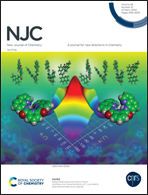Synergistic purification of chromium-containing wastewater via adsorption-photocatalysis induced by multiple defect-containing CuS/Cv-CNNs†
Abstract
To address the water pollution problem caused by hexavalent chromium, this study took advantage of a multi-defect adsorption mechanism and constructed a multiple defect-containing type-II heterojunction material, CuS/Cv-CNNs. This material has simultaneous sulfur vacancies, copper vacancies, and carbon vacancies, which were used to accelerate the removal of chromium from wastewater. Attributed to the formation of electron-rich structures and free-moving ions by the construction of multiple defect sites, the photogenerated carriers generated by CuS/Cv-CNNs-70 were efficiently separated, and a high amount of physical Cr(VI) adsorption was achieved by electrostatic attraction and ion exchange, consistent with a Freundlich isothermal adsorption model. Studies on the adsorption thermodynamics demonstrate that CuS/Cv-CNNs-70 prefers to adsorb Cr(VI) when temperatures are raised. In addition, the removal of Cr(VI) (120 mg L−1) by CuS/Cv-CNNs-70 reached 97.10% after 60 minutes through the synergistic effect of adsorption and visible-light photocatalysis. This finding indicates that the synergistic effect between the multilocation defects stimulated the combined potential of adsorption and photocatalysis of CuS/Cv-CNNs-70 to realize the full utilization of the defects. In conclusion, this study confirms the prominent role of a multiple defect mechanism in wastewater treatment and environmental protection.



 Please wait while we load your content...
Please wait while we load your content...